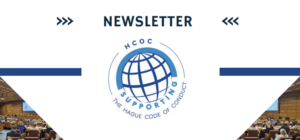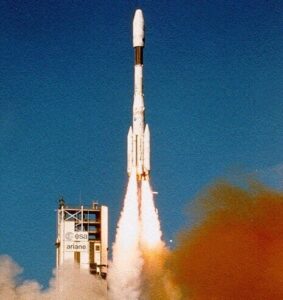Controlling ballistic missile proliferation
Assessing complementarity between the HCoC, MTCR and UNSCR 1540
HCOC RESEARCH PAPERS NO. 4
This contribution written within the specific framework of improving the fight against the proliferation of weapons of mass destruction, recalls the respective roles of governments and private players as well as the universal general principles of export control.
In its international dimension, export control as it works today, has gradually developed and is still developing via a process aiming for optimisation and thus compromise. To avoid fracturing the system, any new development must be guided by caution. This paper therefore extensively focuses on analysing the existing situation.
It indeed seems essential, in a field as complex and as politically and economically sensitive as security, that any proposals for lasting improvements be based on « business » foundations, described as clearly as possible.
These proposals are based on experience. They seek to be pragmatic and primarily reflect the expectations of economic operators. However, with a view to optimising a fundamentally governmental system, the writer hopes that, through this corporate vision, these findings and proposals will give lawmakers the confirmation and operational bases they may be lacking.
January 2018
Arnaud Idiart
Introduction
“Export control of sensitive goods is, by nature, a constantly evolving activity. In terms of guaranteeing the security of nations, export control is no doubt one of the most powerful instruments of foreign policy, enabling exporting countries to send out strong diplomatic signals of either alliance or disagreement to all nations.”
Export control of sensitive goods is, by nature, a constantly evolving activity. In terms of guaranteeing the security of nations, export control is no doubt one of the most powerful instruments of foreign policy, enabling exporting countries1 to send out strong diplomatic signals of either alliance or disagreement to all nations.2 For example, in matters of sanctions, sector-specific, partial or general embargoes almost immediately target deliveries of high-tech products and weapons, the latter very often being closely linked to the former. To keep up with the internationalisation of production and globalisation of supply that gained speed as of the second half of the 20th century, the centre of gravity of sensitive goods control shifted from finished, turnkey systems, to equipment and then components, and finally to technology. It is indeed the know-how necessary to produce basic parts and particularly the know-how required to design complex systems that gives a country real autonomy, and thus the means to proportionally mitigate the influence of and pressure from its historical suppliers. This industrial redistribution in fact triggered the first changes in control of military goods and high technology. For example, in the 1980s in France, except for combat aircraft, the French arsenals, grouped together in a State industrial sector by the “Délégation Générale pour l’Armement” (DGA), still produced most military equipment and particularly the complex weapon systems necessary to guarantee the nation’s total military independence, including in space and nuclear. The various sectors of armament were then gradually privatised and entrusted to industry. Today, the Délégation Générale pour l’Armement (which became the Direction Générale de l’Armement3 in 2009), has practically no industrial activity. It acts as a contracting agency for the complex structures that French military resources represent. The government has therefore successively lost its competency in industrial production and thus today a substantial part of its research and development resources.
This process has prompted historically arms-producing nations to rethink their approach to export control of sensitive goods. In France and the USA in particular, government activities have been transferred from the State to the private sector, with control of the relevant exports shifting from an exclusively “ex ante” to an “ex post” system.
Regarding technology transfer more particularly, control may be necessary from the first stages of research.4 To facilitate the self-classification of technologies used to produce defence or dual-use goods, the French control authorities have recently announced that, save exceptions,5 an export licence application is mandatory for technical data relating to controlled products as of level five (laboratory validation of components and/or models) on the TRL (Technology Readiness Level) scale, which defines the nine successive degrees in technology finalisation. The “ex ante” control of the exported technology is therefore only triggered by the exporting manufacturer once it considers that its invention will be used solely for military purposes or that its diversion for military use is likely.
As we can see, this approach to control greatly relieves the Government of its responsibility for regulatory compliance in exports. At the same time, if the situation deteriorates within the receiving country, or if the supplied products or technologies are not used as expected, it increases the risk, for the EU industrial community in particular, of businesses being directly put in issue by the media, politicians or even by international public opinion. As a result, in a matter of decades, accepting this image risk has become the price that defence industrialists must pay as they face increasingly intense competition from new entrants whose governments may not be as media-sensitive. This growing trend has been particularly noticeable since the arrival of new entrants on the global market such as Ukraine, China or Turkey.6
Faced with this situation, the role of international control circles (including the MTCR7 and The Hague Code of Conduct) is particularly important. Only politically binding adherence, encouraging international dialogue and aiming to enhance collective security, can gradually erase the behavioural differences created by foreign policy excessively centered on national considerations. […]
1 SIPRI – “Trends In International Arms Transfers, 2016” by – Aude Fleurant, Pieter D. Wezeman, Siemon T. Wezeman and Nan Tian – (https://www.sipri.org/sites/default/files/Trends-in-international-arms-transfers-2016.pdf): ”The five biggest exporters in 2012–16 were the USA, Russia, China, France and Germany. Together, they accounted for 74 per cent of the total volume of arms exports”.
2 For memory, in the year 800, the quality of Frankish swords gave the empire real supremacy, so Charlemagne banned the sale of these swords outside his territory. By the Edict de Pistres, in 864, Charles the Bald confirmed this prohibition and even extended it (by banning blacksmiths from working outside the Kingdom) to control of Frankish “high technology” particularly in alloys and quenching!
3 French Decree no. 2009-1180 of 5 October 2009 establishing the powers and organisation of the Direction Générale de l’Armement. Disappearance starting in 1990 of the Direction des Armements Terrestres (armoured vehicles and artillery), then of the Direction des Constructions Navales (surfaces ships, SSN and SNBN), of the Direction des Constructions Aéronautiques (supervisory authority of DASSAULT AVIATION) and of the Direction des Engins, the supervisory authority of AEROSPATIALE (cargo and training aircraft, military helicopters, ballistic missiles and observation satellites).
4 Just after the observation level or description of fundamental scientific laws.
5 Particularly as regards technologies related to the Proliferation of Weapons of Mass Destruction (Nuclear, Biological or Chemical).
6 SIPRI – “Trends in international arms transfers, 2016”; compared to the 2007-2011 period, exports from China, Turkey and Ukraine respectively increased by 74%, 180% and 49%, to the detriment of France -5%, Germany -36% and the Netherlands -11%.
7 Missile Technology Control Regime



